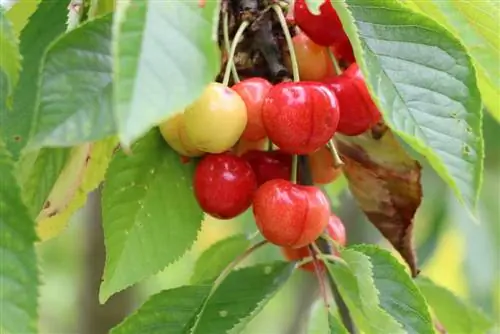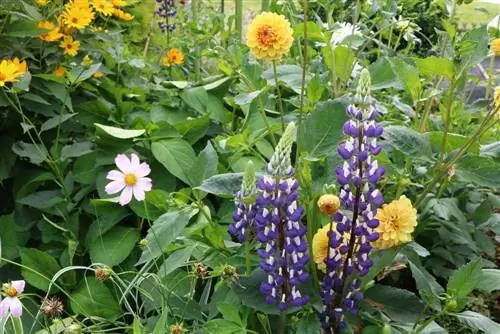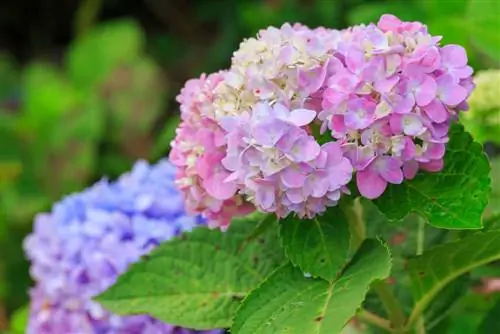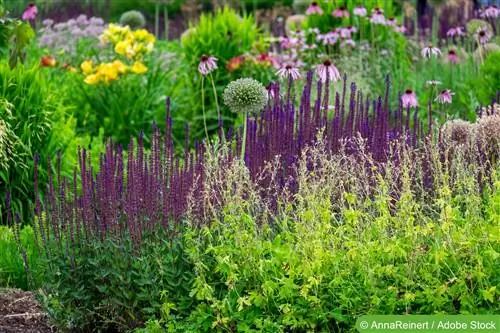- Author admin [email protected].
- Public 2023-12-17 03:39.
- Last modified 2025-06-01 06:48.
The plant received the German name delphinium because of small flower appendages that are somewhat reminiscent of the spurs that the knights had on their shoes back then.
Profile
- Species / Family: Perennial. Belongs to the buttercup family (Ranunculaceae)
- Care effort: Medium. Sensitive to sub-optimal site conditions and lack of care
- Foliage: Hand-shaped, deeply lobed leaves in fresh green
- Growth: Tightly upright, bushy and compact growth with tight, straight flower stalks
- Height / width: 30 to 200m high and 20 to 60cm wide
- Flowering time: June to August with long flower candles consisting of dense blue, violet, yellow, red or white flowers that shimmer silky in the sunlight. Re-blooming possible in summer; To do this, cut back after the first pile to approx. 10-15cm above the ground. Then water well and fertilize
Location
Sunny protection and cool, if it is very bright it will also tolerate partial shade. Humus and nutrient-rich, sandy loam soil, well drained. Shading the root area is useful so that the soil does not heat up too much, which weakens the plant (increases susceptibility to disease or pest infestation)
Partner
Especially yellow, orange or pink flowering perennials. Keeps the tall bearded iris (Iris Barbata-Elatior) aphid-free and makes it grow he althier and stronger
Don't get along
- Don't like people right next to you
- Does not tolerate strong-growing perennials in its neighborhood
Care
Tall varieties support. Protection from snails is necessary, especially when budding in spring. Compost or organic fertilizer in spring, no further fertilization required, otherwise the plant will have weak leaves and become susceptible to pests or diseases. Water well when dry
Planting time
Autumn. Can also be sown directly outdoors from February to April. You have to expect a germination time of 12-20 days at a temperature of 12-16 degrees Celsius
Propagation
By division or cuttings in spring
Wintering
Mostly hardy, but some species are sensitive to frost
Cut
After the first pile, cutting back to approx. 10-15cm above the ground encourages re-blooming in autumn
Rejuvenate delphiniums
The entire nest is carefully lifted out of the ground with the spade and then divided in the middle with the spade blade. The spade blade should therefore be sharp. Individual pieces of approximately the same size are then removed with your hands and replanted, whereby the new substrate should be prepared with a little fertilizer. To improve growth, water thoroughly so that the roots get proper contact with the soil.
Diseases / Pests
Locations that are too shady weaken the plant and promote diseases and pest infestation
Powdery mildew
- White wipeable covering
- Cut off affected shoots
- If the infestation is severe, use spray (follow dosage instructions)
- A plant strengthening agent can be used as a preventive measure
- Plant resistant varieties (such as `Doubles mixture.
Snails
They are very popular with snails, especially the new growth needs to be protected urgently. If the feeding damage is too great, delphiniums will not bloom or will even die.
Special features
- Originates from the Northern Hemisphere
- Considered to be the most popular garden plant in Germany
- It is often called the blue jewel of the garden because of the striking flowers
- Very popular bee feeding place
- Low varieties can also be cultivated in containers
- Support tall varieties as early as May
- Very good and durable cut flower
Considered a long-lived perennial that should only be rejuvenated after about 10 years. Some varieties become lazy after just 4-5 years, then pick them up and replant or divide. Weakens if the location is not optimal or if there is a lack of care and is then very susceptible to diseases or pest infestation
Species
Large-flowered delphinium - dwarf delphinium (Delphinium grandiflorum)
- Height 30-50 cm
- Blooms from June to August with cup-shaped gentian blue flowers
- Cannot tolerate low temperatures, so winter protection is necessary
- Can collapse in harsh areas despite protection
- Comes from western China and Siberia, where it usually only grows as an annual and produces offspring by releasing seeds
Tall delphinium (Delphinium Elatum hybrid)
Height 80-200cm, 40-60cm wide. Blooms from June to July with flower candles consisting of densely seated large flowers in purple, blue, white or pink often with a different colored eye. Upright unbranched growth. Perfect classic rose companion. Probably the most magnificent delphinium and most important hybrid group. Characterized by long and dense inflorescences.
Low delphinium (Delphinium belladonna hybrid)
Height 100-120cm. Blooms from June to July with clusters of blue, purple or white flowers. Abundantly branched growth. The difference to its big brother (the tall delphinium) is small but subtle. The flowers sit loosely on the flower candles, not very densely in the tall types. It also has good branching, while the tall delphinium does not form any branches
Summer delphinium - field delphinium - field delphinium (Delphinium consolida, Syn. Consolida regalis)
Flowers in pure blue. Can be grown from seed better than any other species
Pacific delphinium (Delphinium Pacific hybrid)
The Delphinium Pacific hybrids from the USA grow to a height of approx. 1.80m, but are not particularly suitable for German gardens as they do not appreciate our climate and tip over very easily
Varieties (selection)
- `Arrows®: height 120-150cm. Blooms from June to September in purple, pink, yellow or white; often also available as a mixture. It also tolerates partial shade quite well. Considered to be very stable
- `Atlantis: Low delphinium. Flowers in violet blue
- `Mountain sky: High delphinium. Flowers in June and from August to October with sky blue bell-like flowers
- `Black Night: Delphinium Pacific hybrid. Height 180cm in dark purple, very striking
- `Blue Dwarf: Large-flowered delphinium. Height 50cm. Blooms from June to July and again in September after pruning with bright blue flowers. Branched growth
- `Blue whale: tall delphinium. Considered a top variety
- `Coral Sunset: Height 100cm. Blooms from June to August with exceptional coral red
- `Doubles mix: New Zealand mix of F1 hybrids. Newer variety. Height 120-150cm. Blooms from June to September with fairly loosely set flower candles with slightly double flowers in light blue, pink and white. Considered mildew resistant
- `Faust: High delphinium. Height 150cm. English variety with ultramarine blue flowers. Dark center and dark stems
- `Finsteraarhorn: High delphinium. Considered a top variety with deep blue flower candles
- `Gentian Blue: Summer delphinium. Deep pure blue flowers
- `Kings Blue: Popular variety. Height 120cm. Blooms from June to August with dark blue-purple flowers with a contrasting white eye. Considered stable
- `Lancer: High delphinium. Considered a very stable variety. Medium blue flowers with white eye
- `Magic Fountain Blue: Bright dark blue flowers
- `Magic Fountain White: Pure white flowers
- `Merlin: Tall delphinium. Height 170cm. Flowers sky blue with white flower center
- `Morning dew: sky blue flowers
- `Overture: High Dandelion. Early flowering variety with medium blue flowers characterized by a dark blue eye
- `Piccolo: High delphinium. Height 80cm. Blooms in beautiful azure blue
- `Princess Caroline: height 100cm. Blooms from June to August in a delicate, very romantic pink
- `Temple Gong: Night Blue Flowers
- `Peace of Nations: Low delphinium. Height 100cm. Flowers in azure blue
- `Magic Flute: High delphinium. Late blooming blue with pink eye






